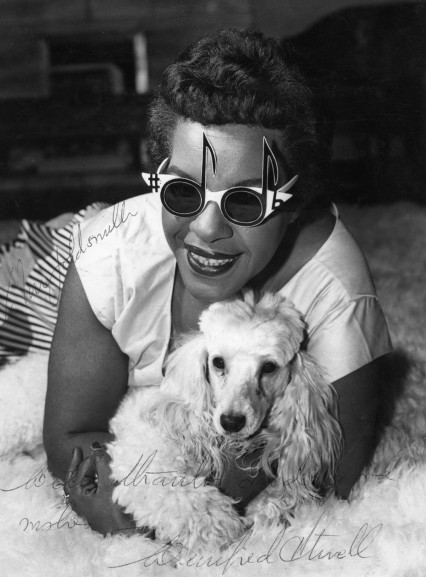
Winifred Atwell. One of Britain’s biggest stars in the 1950s. Modelling Oliver Goldsmith’s sunglasses.
At around eight o’clock on the Saturday evening of 14 April 1981 a Molotov cocktail was thrown through a window of The George Hotel on the corner of Effra Parade and Railton Road in Brixton. It was the second night of the Brixton riots and it was no coincidence that the pub had been targeted – the landlord was infamous in the sixties and seventies for his treatment of local black people and he had been reported to the Race Relations Board for his behaviour.
In the 1970s the pub had been the subject of several local marches and The South London Press, not exactly known to be at the vanguard of radical black separatism, wrote that the arson was “undoubtedly an act of revenge for years of racial discrimination.”
It was relatively un-noticed that the welding shop directly across the road from the George at 82A Railton Road was also set alight. The building all but burnt down during the night and would eventually be demolished.
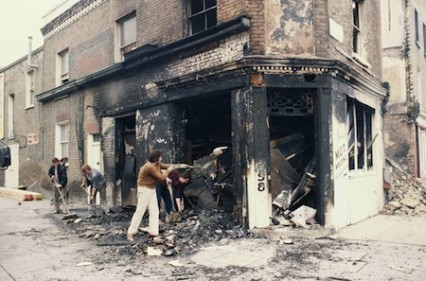
What was left of 82A Railton Road after the 1981 Brixton Riots.
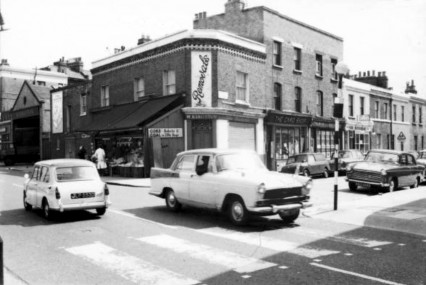
82A Railton Road around 1975.
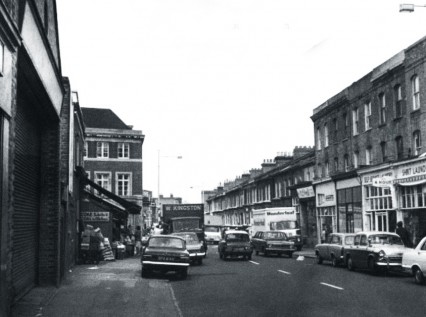
Railton Road in 1975. The George pub can be seen in the background on the left behind the greengrocer’s awnings.
The 1981 riots were mainly a reaction to the very heavy-handed Metropolitan Police’s ‘Operation Swamp 81′- it was rather horrendously named after Margaret Thatcher’s 1978 World in Action interview where she said “if there is any fear that it [Britain] might be swamped people are going to react and be rather hostile to those coming in.”. To be fair, and sometimes this isn’t remembered, Thatcher also said in the interview, albeit maybe patronisingly, that “in many ways [minorities] add to the richness and variety of this country”.
It certainly isn’t remembered now, and I doubt it was in 1981, but the building at 82A Railton Road that burnt down that night once housed maybe the first black women’s hairdressers in London. It had opened in 1956 and was called The Winifred Atwell Salon.
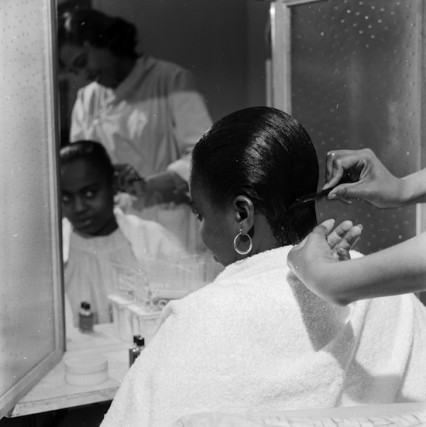
A customer at Winifred Atwell’s hairdressing salon has her hair straightened out. 1957.
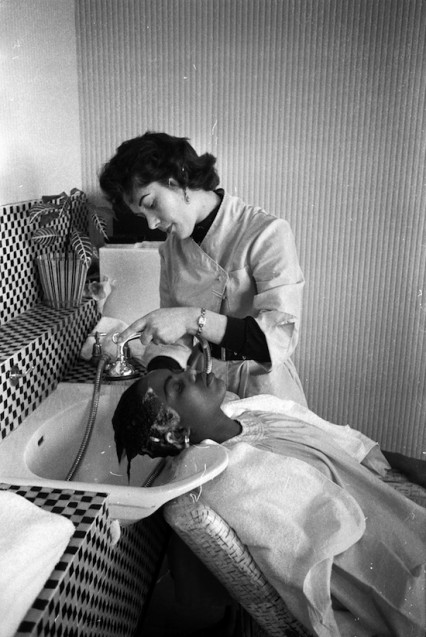
Winifred Atwell’s hairdressing salon, 1957.
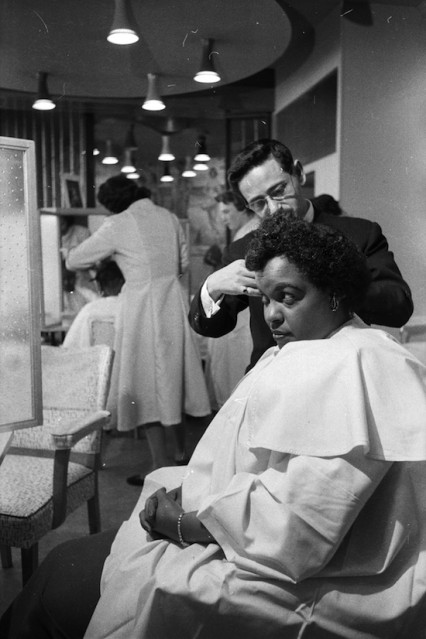
Winifred has her hair straightened out at her salon in Brixton, 1957.
In the mid 1950s Winifred Atwell was undoubtedly one of Britain’s most popular entertainers. Trinidadian-born, her undisguised cheerful personality and well-played honky-tonk ragtime music brightened up many a ‘knees up’ in the fifties. In fact when Atwell reached number one in 1954 with ‘Let’s Have Another Party’, she became the first black musician in this country to sell a million records.
Between 1952 when she reached number five with ‘Britannia Rag’ (written for her appearance at the Royal Variety Show that year), and 1959 when Piano Party reached number ten she had eleven top-ten hits and is still the most successful female instrumentalist to ever have had featured in the British pop charts.
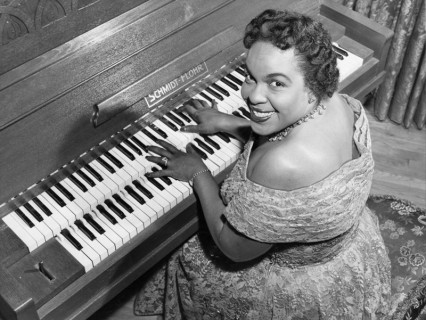
WInifred at the piano.
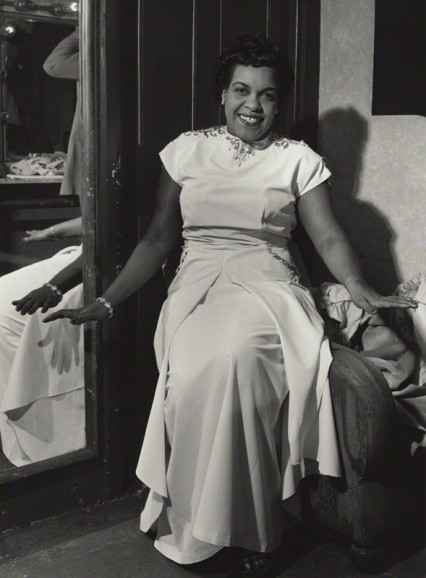
Winifred Atwell by Walter Hanlon in 1952.
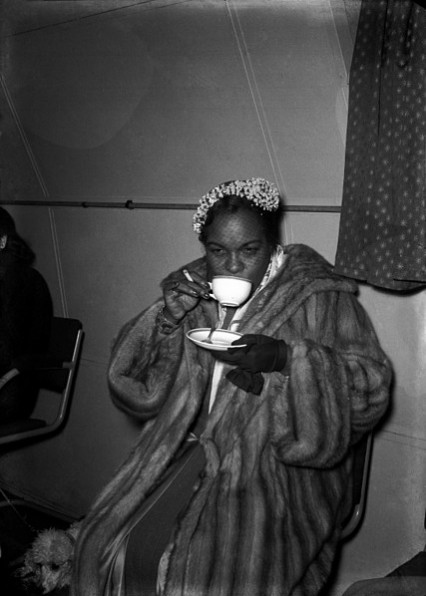
Winifred having a cup of tea and a cigarette before performing in 1952.
At the peak of her popularity her hands were insured for £40,000. It was said, and how many of us would like to sign a legal document like this, that there was a clause in the insurance contract stipulating that she must never wash the dishes.
Atwell, was born in Tunapuna, near Port of Spain in Trinidad around 1914 (most sources say that year but according to her marriage certificate it was 1915 and on her grave it says 1910) and had been playing Chopin recitals since the age of six. After the war she went to study music in New York under the pianist Alexander Borovsky, but arrived in London in 1946 to study classical music piano at the Royal Academy of Music. In the evenings she supported herself by playing ragtime and boogie-woogie at clubs and hotels around London. She had learnt the music playing for servicemen during the war in Trinidad.
A year after Atwell arrived in London she married Reginald ‘Lew’ Levisohn, who gave up his stage career as a variety comedian, and become her manager. Encouraged by Lew, and not discouraged by her professor at the Royal Academy, the former child prodigy was skilfully groomed for stardom and by now she was playing her piano in a rollicking honk-tonk upbeat style.
In 1948 Winifred was booked at a Sunday charity concert at the London Casino (originally and now the Prince Edward Theatre in Old Compton Street) in place of the glamorous actress and singer Carole Lynne who was unwell. The impresario Bernard Delfont, who was married to Lynne, had heard from the agent Keith Devon about a “coloured girl, a pianist, who has the makings of a star.” Winifred Atwell, to huge applause, ended up taking several curtain calls and was immediately signed up by Delfont to a long-term contract.
Within four years she was playing for the new Queen Elizabeth at the 1952 Royal Variety Performance. Winifred completed her act with ‘Britannia Rag’ – a piece of music she had written specially for the occasion.It received a rapturous reception, not least from the Queen, and it was to be her first big hit, reaching number five over Christmas and into the New Year.
Atwell brought the two worlds of her classical piano training and her popular ragtime honky-tonk into her performances. She would open her act with a piece of classical music played on a grand piano but after a short while would then change over, to what she and her audiences came to know as her ‘other piano’ – a beaten up and specially de-tuned upright said to have been bought by her husband in a Battersea junk-shop for just 30 shillings.
Her small journey across the stage between the two pianos encapsulated beautifully how she managed to turn her career from a trained European-classical piano player to the more, even though she was Trinidadian, ‘authentic’ black-American rhythmic music for which she was now famous.
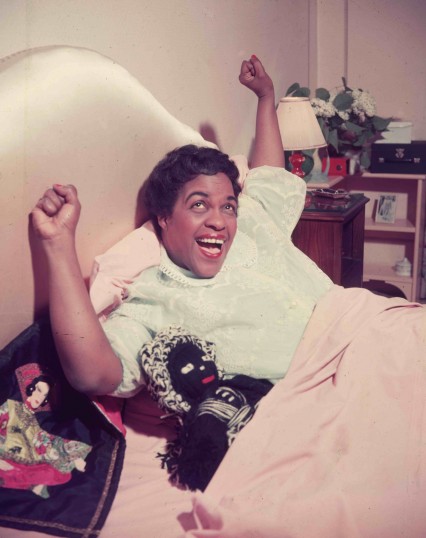
Honky Tonk Winnie
The writer and economist C.B. Purdom wrote that London in the fifties was:
dulled by such extensive drabness, monotony, ignorance and wretchedness that one is overcome by distress.
Purdom wouldn’t be the only person to describe post-war Britain in that way and looking at pictures of Winifred Atwell in the fifties it’s easy to see why she became so popular. The successful record producer and lyricist Norman Newell wrote:
Winnie was around at the right time. Immediately after the war there was a feeling of depression and unhappiness, and she made you feel happy. She had this unique way of making every note she played sound a happy note. She was always smiling and joking. When you were with her you felt you were at a party, and that was the reason for the success of her records.
Introduced by Eamon Andrews, Winifred Atwell playing Poor People of Paris, 1956
In March 1956, and now at the height of her fame, she had her second number one called Poor People of Paris. A few months later she was due to make her second appearance at the Royal Variety Performance which traditionally took place on the first Monday of November. Except this time it never happened. Four hours before the curtain rose, and to the shock of the still-rehearsing all-star cast which included Laurence Olivier and Vivien Leigh but also Sabrina backed by the Nitwits, the show was suddenly cancelled.
The day before on Sunday 4th November, the Observer had written about the Suez Crisis, declaring that the action against Egypt had “endangered the American Alliance and Nato, split the Commonwealth, flouted the United Nations, shocked the overwhelming majority of world opinion and dishonoured the name of Britain”. Later that Sunday afternoon, at a huge rally at Trafalgar Square attended by 10,000 people or more, Aneurin Bevan told the crowd:
If Sir Antony is sincere in what he says – and he may be – then he is too stupid to be Prime Minister.
The next day the Royal Family decided that maybe it would be best to cancel the show. Bernard Delfont wrote in his autobiography that after the cast were informed: “Winifred Atwell gave an impromptu party in an attempt to lift our spirits.” Whether the Queen’s spirits needed lifting as well we don’t know but Winifred performed later at a private performance for the Queen and Princess Margaret at Buckingham Palace where she played Roll Out the Barrel and other Royal favourites.
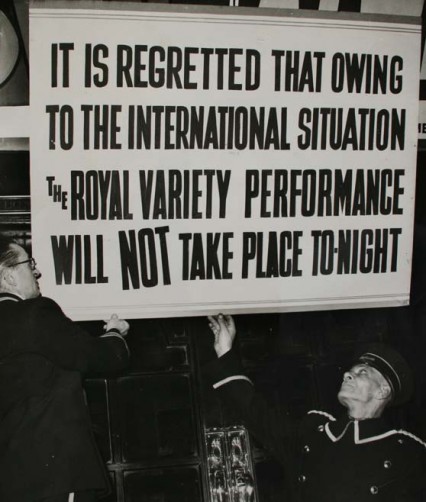
And it didn’t. Bernard Delfont complained that he lost a lot of money.
In 1956, Winifred opened her hairdressing Salon on Railton Road. She had lived initially in the area, although was now living in Hampstead, and still had property in Brixton. A very young Sharon Osbourne, then Sharon Arden, and her father Don “Mr Big” Arden – manager of Gene Vincent, Small Faces, ELO and Black Sabbath, lived in a nearby house rented from Winifred Atwell at the time.
Isabelle Lucas, originally a Canadian actress who performed in many National Theatre productions and remembered as Norman Beaton’s wife in The Fosters and also in two separate roles in Eastenders wrote about Atwell:
In those days there were no black salons for black women in this country. Black women styled their hair in their kitchens. I needed advice on how to straighten and style my hair, but I didn’t know any black women in Britain. I had only heard about Winifred Atwell. So one day I looked her up in the London telephone directory and found her listed! I rang her, and to my great surprise she answered! I explained my predicament, and she invited me to her home in Hampstead. It was as easy as that! I met her lovely parents ,whom she brought to this country from Trinidad, and Winifred gave me some hair straightening irons.
At the height of her career Winifred Atwell was one of Britain’s favourite performers. She had her own series on ATV in 1956 and another series on the BBC the following year. For a black woman of that era this was nothing short of extraordinary but unfortunately nothing remains of this TV history.
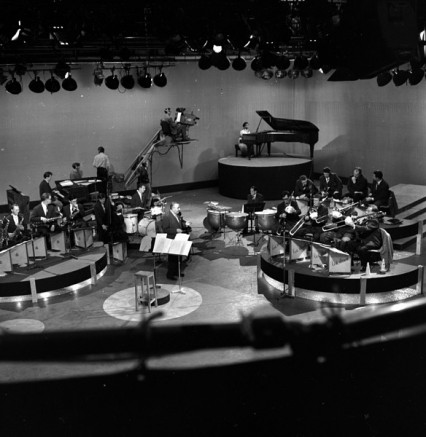
Winifred performing with the Ted Heath Orchestra at the BBC, 1957.
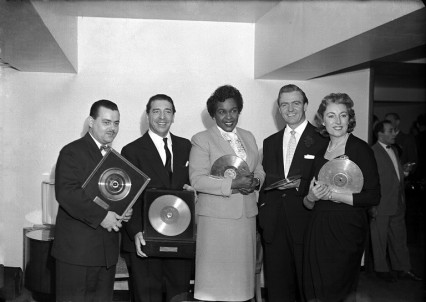
Winifred Atwell with David Whitfield, Vera Lynn, Eddie Calvert and Mantovani. 1953.
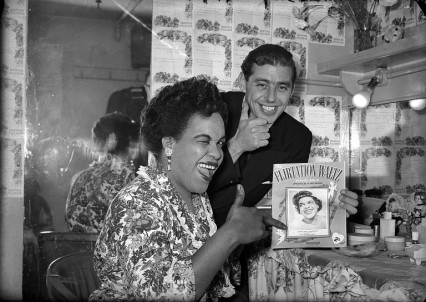
Winifred Atwell in 1953 with fellow pianist Joe ‘Mr Piano’ Henderson.
By the late fifties, however, tastes in music were rapidly changing and Winifred Atwell had her last top ten hit in 1959. Atwell’s manic style either sounded old-fashioned – the era of Rock ‘n’ Roll was now a few years old and not going away – or to people who still liked her style, Russ Conway had taken up her baton and would have six top ten hits in 1959 and 1960.
Winifred Atwell first toured Australia in 1958 and her popularity was such there that when record sales started to dramatically fall in Britain she spent more and more time there. She started to only return for club bookings and the odd television appearance. By 1961 her hairdressing salon in Railton Road had been sold and the premises became A.C. Skinner and Co. Builders merchants.
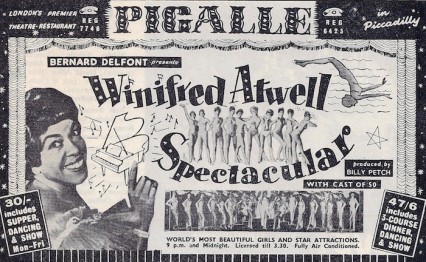
Winifred booked at the Pigalle nightclub in 1961.
In 1971 Atwell was granted permission to stay in Australia and the Daily Mirror reported on the news:
Pianist Winifred Atwell has been given permission to settle down in Australia as an immigrant. She has been told this officially in spite of the country’s ‘White Australia’ policy. An Australian immigration official said yesterday that she had been granted residence because she was ‘of good character and had special qualifications.’ Immigration Minister Mr Phillip Lynch said: ‘We will not stand in the way of an international artist of such repute’.
In 1978 Atwell’s husband Lew died and she never really recovered. In 1981, at around the same time the flaming bottle of petrol was thrown through the window of what used to be her hair salon on the Railton Road, she was finally granted Australian citizenship. She died just two years later from a heart attack in Sydney on 27 February 1983.
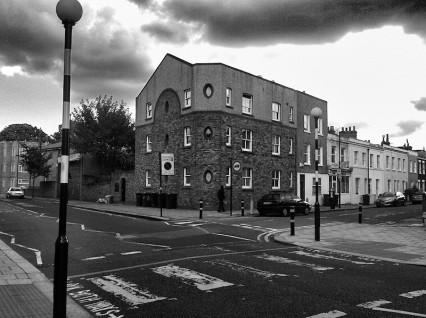
The corner of Railton Road and Effra Parade in 2012. The original building, that once housed Winifred Atwell’s Salon and was burnt down in 1981.
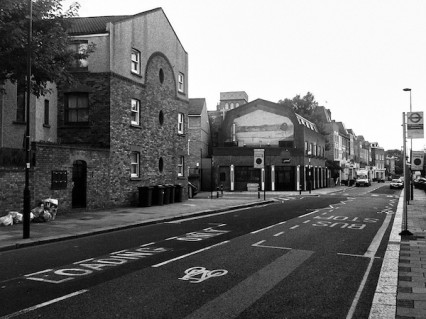
The view down Railton Road from the other direction. Showing where the George pub once stood. 2012.
Various versions of Winifred playing Black and White Rag, which became the theme tune for BBC’s snooker series ‘Pot Black’.
Many thanks to Stephen Bourne whose book Black in the British Frame – The Black Experience in British Film and Television’ (Continuum, 2001) helped immensely in writing this post.
All 13 episodes of The Winifred Atwell TV Shows actually do still exist and are just gathering dust in archives at The British Film Institute in London when they could be bringing pleasure to many fans.
ITV currently own the rights.
However, they won’t release them on DVD because they don’t think there is any demand, despite much evidence to the contrary.
Yes, I did see those. From 1961 and not the original series from the fifties. It also says that they might have been produced in Australia, which would have made sense. I’ll investigate.
[...] story of people and place connections … the place being 82A Railton Road, Brixton. Made my day. Hat tip to BifRiv. Share This [...]
Yes, they are the ones produced by Pagewood Studios in Sydney.
I just can’t understand why they won’t release them on DVD.
Welcome back. Wonderful piece just beautifully illustrating so many delights, highlights and hypocrisies – but most of all I just love the interconnectedness of all things, from Winifred Atwell to Black Sabbath in one leap. Simply fabulous.
Welcome back. Wonderful piece just beautifully illustrating so many delights, highlights and hypocrisies – but most of all I just love the interconnectedness of all things, from Winifred Atwell to Black Sabbath in one leap. Simply fabulous.
Always an education! Carry on!
I first visited Brixton on the night of the ‘uprising’ (as a passive but supportive onlooker). I decided to move there asap, it seemed like my kind of town. It still is. One tiny snippet of local interest is the still extant fish ‘n’ chips shop on Effra Parade, just visible in the two photographs giving a view of the Parade, it is the white facade three shops down from Ms Atwell’s salon. On the night after the 1987 ‘hurricane’ a crowd gathered outside to see a crew filming part of ‘Buster’, the shop having a rare authentic 50s/60′s range. Somehow I was able to resist the charms of catching a glimpse of Phil Collins and concentrated instead on sawing off interesting lumps of wood from fallen trees. The pub they built to replace The George has all the architectural charm of the Brixton Recreation Centre (that hideous political sop), where all too few drinkers were prepared to mingle harmoniously; I believe it is to be soon demolished and become residential, just like the hairdressing salon itself.
Atwell’s career seems to have some parallels with that of the great Hazel Scott. Like Atwell, Scott was born in Trinidad and was a piano prodigy, studying classical piano at Juilliard. She also became a famous jazz musician as well as singer. And she had her own TV show and appeared in movies and nightclubs. You can see Scott in such films as ‘Rhapsody in Blue’ and ‘The Heat’s On.’
Off topic although this Atwell story is very well done like all other blogged ANOTHER NICKEL IN THE MACHINE stories. Anyway wondered if ANITM item of value and interest would be the old EMPRESS THEATRE BRIXTON. Born in the area in the late 30′s and still living locally I know the E T was very popular. Anyway a well intentioned passing thought .
Small point – re the foto sequence – in the Railton Road scene date 1975 which refers to THE GEORGE pub in the fairly near distance on the left. To the fore on the left in the foto there is a pair of large entrance type garage doors – in the period in question I worked at times opposite in the then active PEOPLES NEWS SERVICE at 119. I recall that viewing the large garage entrance which I often had occasion to there was large format signwriting refering to WINIFRED ATWELL – it was a form of advertising but I cant recall now the full text but for sure it promoted WINIFRED ATWELL. Such signage is not visible in the foto – or it is possible the W A promotion was on the immediately adjacent wall poster which is end on visible in the above foto.
I spent the summer working as stage crew on the opening ceremony of the 2012 Olympic Games. I was stationed below the stage operating one of the lifts for the dancers in the Thanks Tim section of the show and during the rehearsals I noticed that one of the first pieces of music played was the theme tune to Pot Black which I thought was a bit odd but now makes sense as a hat tip to Winifred
This is a wonderful tribute to the great Winifred Atwell, but I am dismayed that you have not credited the source of some of the material quoted here: Stephen Bourne’s chapter ‘Honky Tonk Woman’ in his award-winning book Black in the British Frame – The Black Experience in British Film and Television’ (Continuum, 2001). Stephen spent many years researching Miss Atwell’s career, and it is his interviews with Norman Newell and Isabelle Lucas which are quoted here. Stephen does not mind you using material from his book, but he would appreciate some credit for his hard work. Apart from that, congratulations on a superb and fascinating tribute.
This is such a wonderful blog – more please!
I second Jamie’s comment. Nothing new since October! I feel bad moaning because I’m sure this a labour of love and brings little reward – but I’m sure there’s many of us out here who appreciate the effort and love the result.
I am SO pining for an update……
I am fair pining myself away.
Good day! This is my 1st comment here so I just wanted to give a quick shout out and tell you I really enjoy reading through your articles. Can you suggest any other blogs/websites/forums that cover the same subjects? Thanks!
Think you have this item slightly wrong, Her hairdressing salon was on the corner of Chaucer road not the corner of Effra parade as you show, that was Roy Kingston’s fruit and veg shop. I was born on Railton Road in 1948 and was living there when nearly opposite her shop when she opened it and I used to have the base board of the cake she had made for the opening and outside there used to be a cigarette machine her shop was opposite the off licence owned y Mr Duval
In response to Ian Cameron, in the late 40`s through to the early seventies that large garage door used to be the storage area of Roy Kingston’s fruit and veg stall ( he used to house his great Dane dog in there as well)
David, I’ve had to rack my brains over this (we lived in Mayall Road from when I was three (1956) and then moved to the St. Jude’s School end of Railton Road when I was 12. I left the area in 1973. I never knew about the Winifred Atwell connection, so I’ve learnt something there, but I think you’re right about her salon being on the corner of Chaucer Road, not Effra Parade. If so, wasn’t it a minicab hire office before the riots? The one thing I do remember with absolute clarity was Mr Snook’s sweetshop in Leeson Road, just along from the Windsor Castle.
I posted information a week ago confirming that David’s observations (above)are correct and Winifred’s Salon was on the corner of Chaucer Road, not Effra Parade. Why haven’t you published it?
I too lived in flats in Effra Parade from 1952 to 1964 and used to walk to and from Sunday school and cubs and scouts from the Effra Parade junction up to St Jude’s Church Hall at Roy 213 Railton Road nearer to Herne Hill Station. I too remember that Kingstons Greengrocers was on the corner of Effra Parade opposite the George and that Winifred Attwells Hairdressing salon was further up on the corner of Chaucer Road. Before that it was a car showroom
Reply to Malcolm – 13 April.
Very impressed that you can remember that St Judes Primary School was at 213 Railton Road! I lived at 215 – literally on the other side of the school wall. I can remember that just after I left St Judes in 1965, the school attained a certain notoriety as the most overcrowded school in London, and I can still recall the footage on the BBC evening news of pupils having to climb over other children’s desks to get to their own!
i can also share your memories of effra parade! I grew up in effra parade, went to effra primary school, worked at Roy kingstons (aka Roy turner). Yes, Winifred Atwells was definitely on the corner of Chaucer road. There was a club called “the glass bucket” just opposite, a ‘drinking club’ !
Next to it was a doctors surgery, dr howlett, who drove an old black saloon car which he kept for years. The fish and chip shop on effra parade was run by Ernie , an Italian gentleman. Along with his wife and daughter anna. Next door was a barbers where I used to have a short back and sides for 1/3d. His name was Alan. Then there was a newsagents where we were able to buy fireworks (including penny bangers) for guy Fawkes night. Does anyone remember the off license at the other end of the road and the bike shop?
Reply to William. I didn’t know the Drs surgery but I did know the fish shop. As you say they were Italian and their name was something like Amatrudo. There was an older son Tony. I also remember the the newsagents with the penny bangers and the 1d in the slot chewing gum machine outside – Richardsons. Yes I rember the off licence at the other end of Effra Parade – Halls – and the cycle shop Boxalls. Also the grocers Ellis’s – the dairy Morris’s and the shoe repairers.
I was born in Barnwell Road in 1947 and lived there for 20 years. Dr Howlett (I had quite forgotten the name until William mentioned t) was our family doctor, his waiting room was a converted shop with the plate glass window painted brown. No appointments in those days! I used to cut through the Effra School playgrounds to fetch our fish and chips from the shop in Effra Parade. And Winifred Attwell’s was most certainly on the corner of Chaucer Road and not Effra Parade.
My Nan loved Winnie Atwell. I grew up in the Brixton area during the mid 1940′s until 1969 when I got married and moved away. I had a fantastic childhood roaming the streets during the school holidays, collecting old newspapers and selling them for a few coppers. Enjoying carefree days at Brockwell Park. The market was a good place to get some free oranges or apples that had been thrown out by the stall holders. I went to Effra Parade infant and Junior school. Mr. Nicholson was the headmaster. I think I let him down on several occasions. Then on to Santley Street and finally Tulse Hill School. I’m 74 this year and still have a fond memories of those days. We were poor but happy.
Reply to William: my grandad owned the glass bucket club in railroad road. my family has very little information about him or the club as he left London I believe after the club closed. My dad did have a flyer for a club night but it was lost. Any information or memorabilia would be appreciated. thanks